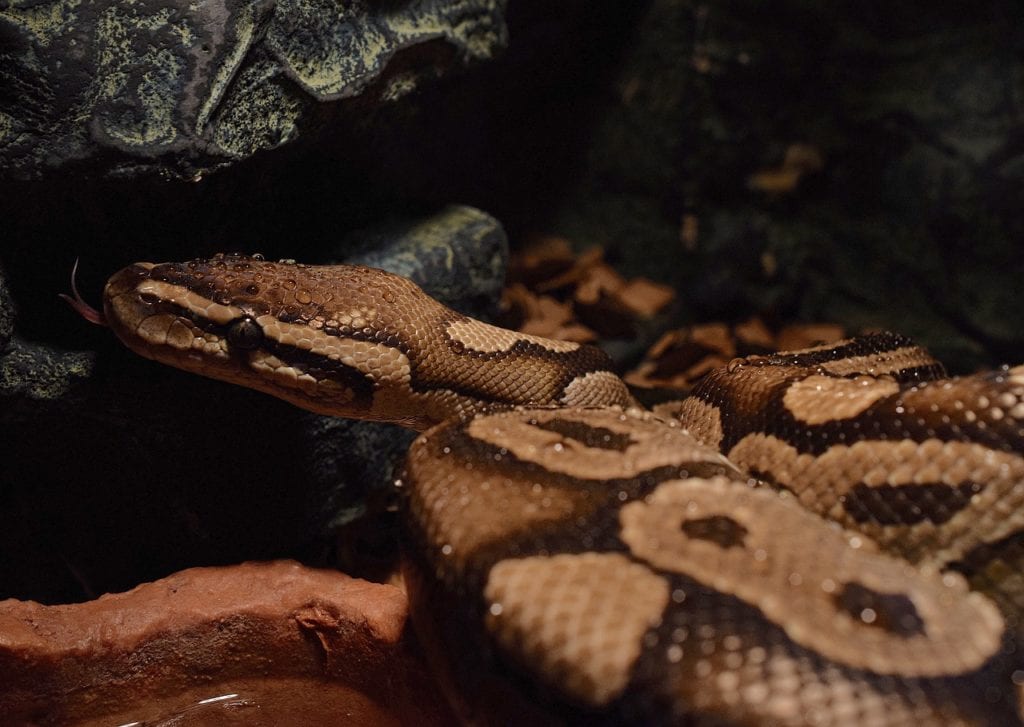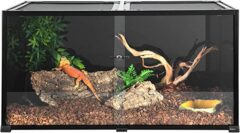Ball pythons are one of the most amazing pets that one can own. They are friendly and can have a very long lifespan. Like any other pet, pythons need an excellent setup to feel secure.
Creating an impressive setup will require you to be very knowledgeable, especially if you are a beginner. Some things to consider when setting up a proper enclosure include temperature, humidity, size and caves. If you get it right, your ball python can live a healthy and happy life. Below is a simple outline that will help you set up a ball python habitat.
How do you set up a habitat for a ball python?
The ultimate ball python setup involves a suitable enclosure that allows your pet to climb, hide and be truly happy. It should provide the ball python with the right amount of light, heat and humidity to be healthy. Below are ball python enclosure ideas you can use.
Begin with a cage
You can use various suitable enclosure types as a cage for your ball python. Some of the common ones are rack, plastic and glass systems. One vital point to consider when choosing a ball python enclosure is size.
Most ball python experts recommend using the largest ball python enclosure size possible. The minimum recommended size is 4-by-2-by-2-feet.
Decide on the substrate or bedding
The base of the ball python enclosure is vital to your pet’s happiness. Thus, ensure you have a suitable substrate or bedding for the floor and can consider adding the following:
- Cypress mulch
- Carefresh bedding
- Aspen shavings
- Newspaper
Also, note that ball pythons like wet and warm environments. Thus, consider adding water to the bedding to make the enclosure humid.
Include several boxes in the ball python enclosure
Ball pythons require a safe space where they can hide. Adding multiple hide boxes in the enclosure will ensure that your pet stays relaxed and has less stress. Also, make sure that one of the hide boxes is wet.
Making of the hide boxes wet will prevent your ball python from suffering from dehydration. It will also provide an ideal place to shed.
Maintain proper humidity
Ball pythons require a humidity level of 50% to 60% to shed properly. One thing to note is that too much humidity can be harmful to your pet and may cause skin diseases and respiratory infections.
To maintain proper humidity, mist the python’s enclosure daily using a water sprayer. Also, use a hygrometer to determine whether the humidity in the tank ranges between the recommended 50% to 60%. In addition, make sure to have a water dish in the habitat; it will help add humidity.
Control the heat in the enclosure
Heat control is vital in the ball python enclosure setup. You can control the heat by using a white light heating lamp with a dimmer. Also, track the temperature by using a temperature gun.
Provide adequate lighting
Ball pythons need a habitat with sufficient night and day cycles. Ensure that the habitat provides your pet with 12 hours of darkness and 12 hours of light. Also, ensure that you have a UVB fixture in the cage. The UVB fixture will help stimulate the ball python’s natural night or day cycle.
Include decorations
Even though not necessary, you can have decorations in the enclosure. Some of the things to include are branches or plants. You can also have artificial leaves to beautify the enclosure and ensure the snake can enjoy the scenery.
What size enclosure for a ball python?
Ball pythons need a lot of space in their enclosure to be happy. The general rule is that the habitat should be two times the width and length of your pet’s body. Also, note that you should increase the enclosure’s size as your pet grows. The minimum recommended size for the enclosure should be at least 4-by-2-by-2-feet.
What temperature for a ball python’s cage?
The optimum temperature of about 77 to 85 degrees is vital in a ball python tank. In the enclosure, you will need a cool and warm side. The two sides will ensure that the python, a cold-blooded animal, can regulate their temperature.
During the day, ensure you have heating devices like an infrared heat lamp. The device will help increase the temperature to about 90 degrees Fahrenheit, which is ideal for basking. Apart from the infrared heat lamps, you can consider radiant heat panels, heat pads and heat tape to provide the necessary heat for the ball python tank.
During the night, your ball python will need a habitat with a temperature of about 69–75 degrees Fahrenheit. The lower temperatures at night will allow your snake to cool off.
What do you need for a ball python habitat?
A ball python’s habitat should be as close as possible to its natural environment in the wild. Two essential things your pet will require in the habitat:
- An elevated section where it can climb
- An area to hide
If you fulfill these two demands, your snake will have a healthy life. You can also have climbing branches in the enclosure. The climbing branches will allow the ball python to exercise, curl up and bask near the heat source.
You can also add rocks of different sizes so that the ball python has other places to crawl and bask. In addition, add a small water pool. The pool can act as a source of water for your pet. It can be a place where the snake can get wet if the need arises.
Also, make sure that the enclosure has feeding tubes or containers. Part of the ball python’s care process includes providing them with food. Using feeding tubes will help the habitat maintain a clean space.
Summing it up
Providing a suitable ball python habitat is the first step in proper care. The right environment will ensure that your pet grows healthy and will have an incredibly long lifespan. Thus, ensure that the enclosure you provide is as close to its natural environment in the wild as possible.








